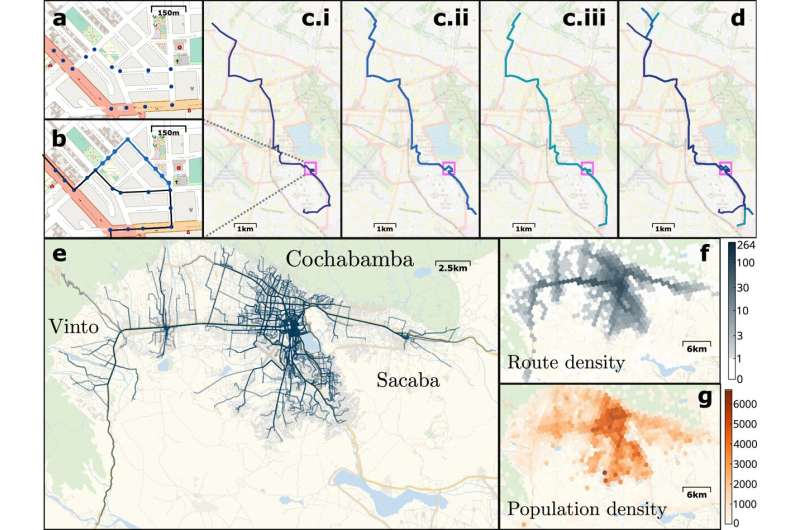This article has been reviewed according to Science X's editorial process and policies. Editors have highlighted the following attributes while ensuring the content's credibility:
fact-checked
peer-reviewed publication
trusted source
proofread
Evidently efficient: Self-organization of informal bus lines in the Global South

Public transport systems vary widely around the world. Developed countries in the Global North usually have centrally planned public transport systems with fixed routes and timetables.
In contrast, in the developing countries of the Global South, making up more than 80% of the world's population, public transportation is mostly provided by informal transport services featuring ad hoc routes, e.g., in the form of privately organized minibus services.
Due to their seemingly chaotic operation, such informal transport services are often considered as inefficient from an outside perspective. Due to a lack of data a systematic comparison has not been possible.
In a new paper recently published in Nature Communications, Kush Mohan Mittal, Marc Timme and Malte Schröder from the Chair of Network Dynamics at TU Dresden analyze and compare the structural efficiency of more than 7,000 formal and informal bus lines across 36 cities and 22 countries.
One of the central surprising findings is that the routes of informal transport self-organize in a way that reaches or even exceeds the efficiency level of centralized services.
Following on from the group's previous research on on-demand ridepooling, i.e., demand-driven shared taxi services, the research group has greatly expanded the scope for the current study and attempted to evaluate an immensely large sample that includes data from very different places around the world.
In the countries of the Global South in particular, informal transport systems often cover areas where publicly organized transport does not offer services or is not affordable for a large proportion of users. In some cases, such services are organized by non-governmental organizations (NGOs), but often by private, commercially motivated actors.
"Our central question in the study was: How are the routes organized in the various systems? How efficient are they? Can we identify specific patterns, which similarities and differences do we see?" explains Schröder.
The study was based on freely available GPS route data for more than 7,000 bus routes from the OpenStreetMap provider. In the case of informal transport services, this data is usually only available if it is collected by local volunteers. Using this data, the researchers analyzed how the routes are aligned with local population densities and the extent of detours being included into the routes.
The findings call into question the general perception of informal transport as an "inferior alternative" to centrally organized services. Here too, more or less fixed routes, lines or travel corridors emerge. The typical routes are fairly straight in the central area of the routes, with more detours at the ends in order to cover larger areas. This pattern can be found in both centrally organized and informal transport, and arises regardless of the different geography of the cities.
"Informal transport, however, has fewer detours and more uniform routes than centrally planned services, so the routes are efficient—and profitable even without the extensive subsidies that are common in the Global North," emphasizes Mohan Mittal.
Other factors that go beyond the examined structure of the routes could not be included in the analysis due to the still limited availability of data for informal transport. However, aspects such as wage levels, vehicle safety, driver training, predictability and reliability of services, etc., of course, play just as an important role in an efficient and sustainable public transport system as routing.
Nevertheless, the findings of the study already show that existing informal systems should not simply be replaced by formal, centrally planned routes. Instead, operators can build on the efficient self-organization and improve the services by increasing the frequency and reliability of informal transport. Public, centrally organized services may also be able to learn from the routing of informal systems.
This comprehensive analysis of informal transport systems underlines the potential benefits and calls for a paradigm shift in the way they are perceived and integrated into urban transport planning.
More information: Kush Mohan Mittal et al, Efficient self-organization of informal public transport networks, Nature Communications (2024). DOI: 10.1038/s41467-024-49193-1





















